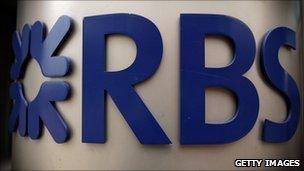Hester concedes RBS to miss profit target
- Published
- comments

RBS's chief executive said it will take longer than the promised five years to hit targets
The good news is that semi-nationalised Royal Bank of Scotland looks like a much more solid bank than it did.
Its ratio of assets (loans and investments) to loss-absorbing equity capital is a fraction over 20 times, down from 50 times in the autumn of 2008, when it was rescued from the brink by taxpayers. Back then, a fall in the value of its assets of just 2% was enough to sink it. Today its assets would have to be written down by 5% for the knackers yard to beckon.
Whether a so-called gross leverage ratio of 20 achieves the correct balance between risks and rewards is moot: some would argue it should be lower still. But it's massively better than it was.
Also, RBS is less dependent than it was on fickle short term wholesale funding, whose availability shrivelled in 2007-8 and put RBS into the intensive care of financial support by taxpayers. The bank's ratio of the loans it has made to its ostensibly stable and reliable deposits is now 112%, down from 154% three years ago.
That said, right now, RBS - like all banks - is finding it harder to borrow for longer periods, because (as you know) the eurozone's debt crisis has spooked creditors.
But RBS has increased its portfolio of liquid assets (these are assets that can supposedly be turned into cash in a crisis) from £155bn to £170bn, which exceeds its £141bn dependence on short-term finance (or finance that could be withdrawn if, for example, the eurozone were to melt down).
And what will seem highly relevant to most of you right now, RBS's exposure to the financially challenged eurozone governments of Portugal, Greece, Italy, Spain and Ireland has been reduced in 2011 from £4.6bn to a comfortably low £1.1bn.
So it is reasonable to assume that RBS has reinforced its foundations and structure to cope with all but the most acute and extreme of financial shocks.
But, interestingly, Stephen Hester has conceded - I think for the first time - that it will take longer than the promised five years for RBS to hit new targets for what he calls "value drivers", which are the profit that the bank earns relative to its equity capital, and its costs relative to income.
Strikingly, over the past year, return on equity fell from 14% to 12% and the cost:income ratio rose, from 56% to 59%.
For what it's worth, the 2013 target for return on equity was more than 15% and the cost:income ratio supposed to be less than 50% by then.
Stephen Hester is blaming two things:
1) A more sluggish economic recovery than he expected, when the five-year plan was launched in 2009;
2) The impact on the group of proposals from the Independent Commission on Banking, to put a ring-fence around retail banking and make sure banks' shareholders and creditors can absorb losses equivalent to 20% of risk-weighted assets.
There will be three important consequences, says Mr Hester.
Royal Bank will shift the balance of its operations further away from investment banking, and more towards retail and commercial banking.
It will endeavour to become even less reliant on wholesale funding.
And it will have to be even more aggressive in cutting costs, which may mean even bigger job losses at the group, on top of the 30,000 odd already announced or made.
When you put all this together, it is hardly surprising therefore that RBS's share price remains in the doldrums.
This morning it was just under 24p, up a bit on the day, but that is a staggering 55% below the value of RBS's net assets per share - and less than half what taxpayers paid for the shares when rescuing the group.
The rehabilitation of RBS is certainly happening - but it is a longer and more painful process than perhaps anyone expected.